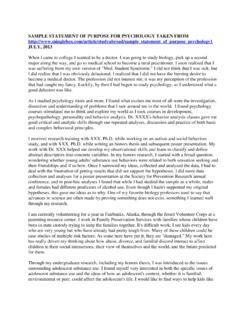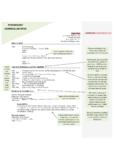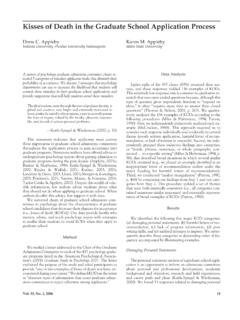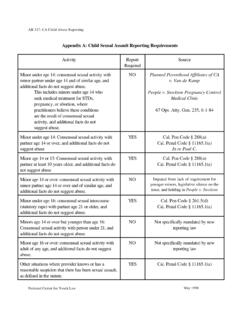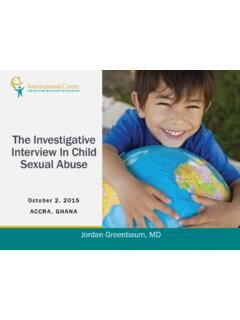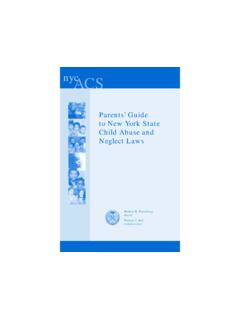Transcription of Forensic interviewing in child sexual abuse cases: Current ...
1 Aggression and Violent Behavior 11 (2006) 195 207. Forensic interviewing in child sexual abuse cases: Current techniques and future directions Lindsay E. Cronch *, Jodi L. Viljoen, David J. Hansen University of Nebraska-Lincoln, USA. Received 22 July 2005; accepted 27 July 2005. Available online 8 September 2005. Abstract In child sexual abuse cases, skillful Forensic interviews are important to ensure the protection of innocent individuals and the conviction of perpetrators. Studies have examined several factors that influence disclosure during interviews, including both interviewer and child characteristics. Numerous interviewing techniques have received attention in the literature, including allegation blind interviews, open-ended questioning, cognitive interviewing , the Touch Survey, truth lie discussions, and anatomical dolls. Recent studies have examined new directions in Forensic interviewing , such as structured interview protocols and the extended Forensic evaluation model.
2 In addition, the child advocacy center model has been established as a strategy to prevent repeated interviewing . child Advocacy Centers provide a safe, child -friendly atmosphere for children and families to receive services. Limitations of the research are discussed and empirically based recommendations for interviewers are provided. D 2005 Elsevier Ltd. All rights reserved. Keywords: sexual abuse ; Forensic interviews; Children Contents 1. Factors influencing disclosure during interviews .. 196. 2. Techniques used in Forensic interviews.. 198. Allegation blind interviews .. 198. Open-ended questions .. 198. Cognitive interviewing .. 199. Truth lie discussions .. 200. Touch survey .. 200. Anatomically detailed dolls .. 200. 3. New directions in Forensic interviewing .. 201. Structured interviews .. 201. * Corresponding author. E-mail address: ( Cronch). 1359-1789/$ - see front matter D 2005 Elsevier Ltd. All rights reserved.
3 196 Cronch et al. / Aggression and Violent Behavior 11 (2006) 195 207. Extended Forensic evaluation.. 202. child Advocacy Center model .. 203. 4. Implications for research and practice.. 204. References .. 206. child sexual abuse is an alarmingly prevalent problem in the United States. According to reports from child protective service agencies, 78,188 children were sexually abused in 2003 at the rate of per 1000 children ( Department of Health and Human Services, 2005). These numbers represent only substantiated cases of abuse , and it is commonly assumed that actual rates of sexual abuse are most certainly much greater. Failure to substantiate and underreporting have led to gross underestimates of the incidence of sexual abuse (Hsu, Sedlar, Flood, & Hansen, 2002;. Tyler, 2002). Furthermore, of the children with substantiated sexual abuse cases in 2003, only 4% were actually removed from the home ( Department of Health and Human Services, 2005).
4 These statistics are unsettling, in light of research suggesting that a history of sexual abuse greatly increases the risk for future revictimization ( , Boney- McCoy & Finkelhor, 1995). For these reasons, skillful Forensic interviews in child sexual abuse cases are extremely important in ensuring that victims and falsely accused individuals are protected and perpetrators are convicted. According to the American Professional Society on the abuse of Children (APSAC), the purpose of the Forensic interview is bto elicit as complete and accurate a report from the alleged child or adolescent victim as possible in order to determine whether the child or adolescent has been abused (or is in imminent risk of abuse ) and, if so, by whomQ. (APSAC, 2002, p. 2). Interviews are typically conducted by law enforcement officers, child protective services personnel, or specialized Forensic interviewers, although medical and mental health professionals often participate as well (APSAC, 2002; Carnes, 2000; Lanning, 2002; National Children's Advocacy Center, 2005a,b).
5 As demonstrated by highly publicized cases, such as that of Kelly Michaels and the abuse allegations involving her daycare center (Bruck & Ceci, 1995), bad interviewing can lead to serious consequences. These may include eliciting false allegations, putting children and families through unnecessary stress, decreasing a child victim's credibility in court, contaminating facts, reducing probability of conviction, draining resources through unsuccessful trials and investigations, and reducing resources available for legitimate abuse cases (Wood & Garven, 2000). To avoid these negative outcomes, Current interviewing techniques must be continuously examined and revised as necessary. The purpose of this paper is to examine the Current techniques used in Forensic interviews with child sexual abuse victims, as well as new directions in research and practice. Empirically based recommendations for interviewers will be discussed.
6 1. Factors influencing disclosure during interviews Children are understandably reluctant to disclose information about abuse . sexual abuse is often a very private, embarrassing, and shameful topic to discuss and many children are unlikely to ever tell their story (Hsu et al., 2002;. Tyler, 2002). For these reasons, it is important that research examine barriers to disclosure and factors that are likely to improve disclosure rates during Forensic interviews. Several factors that appear to influence the disclosure of sexual abuse have been explored in the literature. These factors include individual characteristics of the interviewer ( , gender), the child or adolescent ( , age), and the interview itself. The interviewer carries enormous responsibility in child sexual abuse cases, as he or she can single-handedly determine the probability of disclosure and, thereby, the likelihood of prosecution. An interviewer has the power to elicit false allegations ( , Bruck & Ceci, 1995; Lamb & Fauchier, 2001; Saywitz, Goodman, & Lyon, 2002.)
7 Wood & Garven, 2000), to determine accuracy and amount of details provided by the victim ( , Davies, Westcott, & Horan, 2000; Hershkowitz, Orbach, Lamb, Sternberg, & Horowitz, 2002; Lamb & Garretson, 2003;. Sternberg et al., 1996; Wood & Garven, 2000), and to prevent the victim from disclosing altogether ( , Saywitz et al., 2002; Wood & Garven, 2000). The interviewer's influence may stem from personal characteristics, but is often a function of interviewing skill. Wood and Garven (2000) suggest that a distinction be made between improper interviewing and clumsy interviewing . The authors define improper interviewing as the use of techniques that research has shown to be risky and ineffective. Four categories of improper interviewing techniques are described, including use of reinforcement ( , punishments and rewards), social influence ( , telling the child what others have said), asking suggestive or leading questions ( , introducing information that the child has not Cronch et al.
8 / Aggression and Violent Behavior 11 (2006) 195 207 197. disclosed), and removing the child from direct experience ( , asking what might have happened). These techniques are likely to lead to negative consequences, such as false allegations and reduced likelihood of conviction ( , Bruck & Ceci, 1995; Wood & Garven, 2000). On the other hand, clumsy interviewing is defined by Wood and Garven (2000) as failure to use recommended interviewing techniques. Clumsy interviews may occur even with highly trained interviewers, as a result of forgetfulness, lack of skill, and lack of supervision. Consequences of clumsy interviewing may include lack of detail in children's responses, reduced credibility of children's statements, and reduced likelihood of conviction. Wood and Garven recommend that law enforcement personnel and caseworkers be trained to recognize and avoid using improper interviewing techniques. Furthermore, supervision is highly beneficial in reducing improper and clumsy interviewing ( , Lamb, Sternberg, Orbach, Esplin, & Mitchell, 2002).
9 Interviews should be taped, and interview transcripts and tapes should be regularly reviewed by supervisors. To avoid improper and clumsy interviewing , certain interviewer qualities are helpful. Wood and Garven recommend that interviewers have experience working with children, previous training in interviewing or counseling, a master's level education, the ability to establish rapport through warmth and friendliness, and the ability to take feedback constructively and change accordingly. In addition to these characteristics, interviewer gender has also been examined as a factor related to disclosure in child sexual abuse cases. Lamb and Garretson (2003) reviewed 672 Forensic interviews of children between ages 4. and 14 across Britain, Israel, and the United States. Their results showed that female interviewers asked significantly more suggestive questions with boys than with girls, while male interviewers did not show a distinction.
10 In addition, girls provided significantly more details to female interviewers than male interviewers, while boys did not show a difference. Children between 4 and 6 years old gave more detailed responses to suggestive utterances made by interviewers of the opposite gender. These results suggest that the match between interviewer gender and child gender may have an important influence on disclosure. While child gender is an important consideration for interviewers, age has been the most widely studied child characteristic influencing disclosure. Overall, younger children tend to provide fewer details and shorter responses during interviews than older children ( , Davies et al., 2000; Hershkowitz et al., 2002; Lamb & Garretson, 2003;. Sternberg et al., 1996; Sternberg, Lamb, Orbach, Esplin, & Mitchell, 2001). In a study that included 142 Forensic interviews with Israeli children ranging from 4 to 13 years old, Hershkowitz et al.
